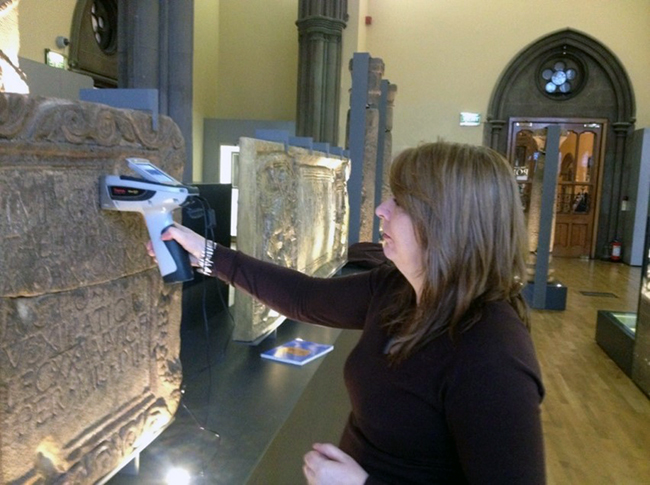Researchers from the University of Glasgow have turned to cutting edge technology to gain a better understanding of the use of colour in Roman sculpture.
Published: 12 December 2017
Paints & Pigments in the Past
Researchers from the University of Glasgow have turned to cutting edge technology to gain a better understanding of the use of colour in Roman sculpture.
Dr Louisa Campbell is currently researching Paints and Pigments In the Past (PPIP) in her role as Postdoctoral Fellow in Archaeology at the University, a project part-funded by Historic Environment Scotland’s Archaeology Programme.
The project team aims to analyse and identify the compounds in pigments used on Roman sculpture, with a focus on distance stones from the Antonine Wall.
Most of the examples available were discovered between the 17th and 19th centuries, and are on display at the University’s Hunterian Museum.
Dr Campbell said: “The Antonine Wall distance stones are a unique and incredibly rich resource that provide valuable information on the Roman Legions who constructed Rome’s north-western frontier.
“Many contain exquisitely carved scenes of combat, religious practice and architecture. It is likely that the sculptures were originally painted for maximum impact, but post-depositional processes have impacted some of the surfaces leaving only trace elements of their original pigments.
“The central aim of the project is, therefore, to identify the pigments originally applied and then to recreate an authentic palette of colours to enable them to be physical and digitally reconstructed. It’s an incredibly exciting opportunity to work with the Hunterian collections and, critically, the use of cutting-edge scientific instruments allows us to undertake non-destructive analysis of important cultural objects.”
Reconstruct
Dr Campbell is using innovative handheld analytical instrumentation – including the p-XRF and Raman spectrometer - supplied on loan from Analytik UK.
Thanks to the highly portable character of equipment, Dr Campbell has also been able to visit other collections for sampling, including the National Museum of Scotland in Edinburgh, the Yorkshire Museum in York and the Great North Museum in Newcastle upon Tyne.
Patricia Weeks, World Heritage Site Coordinator for Historic Environment Scotland said: “This is a great example of an archaeological project using new technology to provide an insight into the use of colour in the Roman World. It helps us to reconstruct, and better understand, what these monuments would have looked like when they were first displayed. The results of Louisa’s work will allow us to consider the wide range of colours that may once have decorate these stones, and will help to inform digital and physical reconstructions of carved stones from the Antoine Wall as part of a wider Heritage Lottery Fund bid.”
Dr Campbell expects to have developed some initial conclusions by early 2018 and will publish her findings for peer review once complete.

Dr Louisa Campbell, using a p-XRF machine on The Hunterian Roman stones, has also used Raman spectroscopy equipment on loan from Analytik UK as part of her research called Paints and Pigments In the Past (PPIP) in her role as Postdoctoral Fellow in Archaeology at the University, a project part-funded by Historic Environment Scotland’s Archaeology Programme.
First published: 12 December 2017
<< 2018

